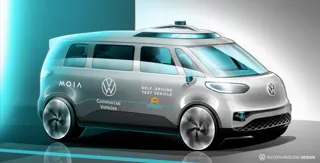Ford has announced a new self-driving vehicle research programme to help businesses understand how autonomous vehicles can benefit operations.
Using a customised Ford Transit van, the research aims to understand how road users would interact with a driverless delivery van, said Ford.
The specially adapted commercial vehicle features sensors that mimic the appearance of a self-driving vehicle and a ‘human car seat’ in control of the vehicle – to enable a hidden driver to drive while giving the impression there is no one at the wheel.
Richard Balch, director, autonomous vehicles and mobility, Ford of Europe, said: “As we plan to bring autonomous vehicles to the roads, it is important that we focus not only on enabling the technology, but on enabling our customers’ businesses.
“Clearly, there is no better way to identify how they may need to adapt than to experience those processes in real life.”
Hermes is the first business to partner with Ford on the programme, where the delivery conpany will operate the research vehicle as part of a 'last mile delivery' pilot.
Ford said by harnessing the experience from delivery firms, the company intends to identify new opportunities and models for autonomous vehicle operations – understanding how existing processes and human interactions can work alongside automated vehicles.
The research vehicles will enable Hermes and other businesses to begin designing how their teams could work alongside driverless vehicles, said Ford.
The two-week research project with Hermes builds on the success of Ford's ‘last mile delivery’ trials in London, in which a team of pedestrian couriers collects parcels from a delivery van and fulfils the last leg of the delivery by foot.
Lynsey Aston, head of product, innovation and onboarding at Hermes, said: “We’re excited to collaborate with Ford on this proof of concept trial, which is all about understanding the potential for autonomous vehicles and if they have a role in delivery in the longer-term future.
“We’re constantly innovating to incubate and then explore concepts like this, and we look forward to the initial findings, which will no doubt be useful on an industry-wide level.”
In the research, the driver will play a ‘passive role’, said Ford. Pedestrian couriers who support the delivery van are equipped with a smartphone app allowing them to hail the vehicle and remotely unlock the load door after it is parked at the roadside.
Once inside, voice prompts and digital screens direct the courier to their locker, containing the parcels to be delivered.
Ford said its researchers are developing a light-based visual language to convey to other drivers, pedestrians, and cyclists what autonomous vehicles intend to do next.
The manufacturer said it has been testing self-driving technology in cities across the U.S. and plans to invest around $7 billion in autonomous vehicles during 10 years through to 2025 – $5 billion of that from 2021 forward – as part of its Ford Mobility initiatives.
In collaboration with Ford's self-driving technology partner, Argo AI, autonomous test vehicles operate daily in six U.S. cities.
























Login to comment
Comments
No comments have been made yet.